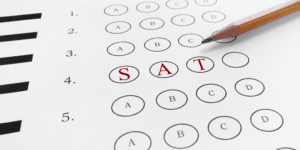Humankind is nothing if not resourceful. As the disruption of everyday life foisted upon us by COVID shows no signs of abating, we’ve continued to find creative and innovative ways to do things from home that were previously strictly in-person endeavors. Telemedicine, virtual dance classes, Zoom first dates – the list goes on. In fact, pretty soon the only thing you won’t be able to do from home is vote!
August has seen the addition of two more at-home activities to that list: the SSAT and ISEE. Both test organizations have announced the launch of at-home testing in order to allow students to take the exams without compromising their health. The systems ensure test security by combining automated elements, such as a secure browser window that prevents students from opening other tabs while taking the test, with a human proctor who monitors testers during the exam.
Parents and students can register for an at-home ISEE test date through their accounts on the ERB’s website; SSAT testers can do the same using their accounts on the SSAT site. Registration is now open for dates through the end of the year. Both sites contain plenty of information about the at-home testing experience, including video tours of the web client that students will be using on the day of the exam and advice about how to prepare for a virtual test day.
It was important that the EMA and the ERB (the organizations in charge of the SSAT and ISEE, respectively) roll out an at-home testing system as soon as was feasible, as fall is comfortably the busiest season for SSAT and ISEE prep. Pushing the release of the at-home option back into October or November would have left students butting up against application deadlines and schools feeling pressured to make a call about a temporary test-optional policy.
The difficulties that students encountered taking the AP exams online earlier this year may well give parents pause as they weigh the benefits of at-home testing. There is reason to be optimistic about the relative success of the SSAT and ISEE in an online setting, however. For one thing, the size of the testing population is significantly smaller. The SSAT website advertises that EMA administers the SSAT to approximately 80,000 students each year over a span of several months; roughly 4.6 million AP tests were taken this year during the dates of May 11-22 alone, according to collegeboard.org. Fewer test-takers means less concern about site traffic and smaller personnel requirements.
It’s also worth noting that College Board was forced to roll out a system to allow millions of students across the world to take AP exams on only a few weeks’ notice; EMA and ERB have had months to develop a system that can handle far fewer students concentrated overwhelmingly in the northeastern United States. That’s obviously no guarantee that the thing will actually, you know, work, but suffice to say that their task wasn’t nearly as imposing as that faced by the CB.
One thing that students should be aware of when taking the at-home test is the impact that the change in format could have on test-taking strategy. Most elements of the test will translate smoothly to a digital medium; however, students should be aware of things like the need to redraw geometric diagrams since they won’t be able to interact with the “pages” of the exam. Likewise, testers may find the Reading section a bit harder to navigate, as they won’t be able to underline key words in the passage in the same way. Fortunately, we know some people who are black-belts in SSAT & ISEE strategy and have plenty of digital materials to work with…




